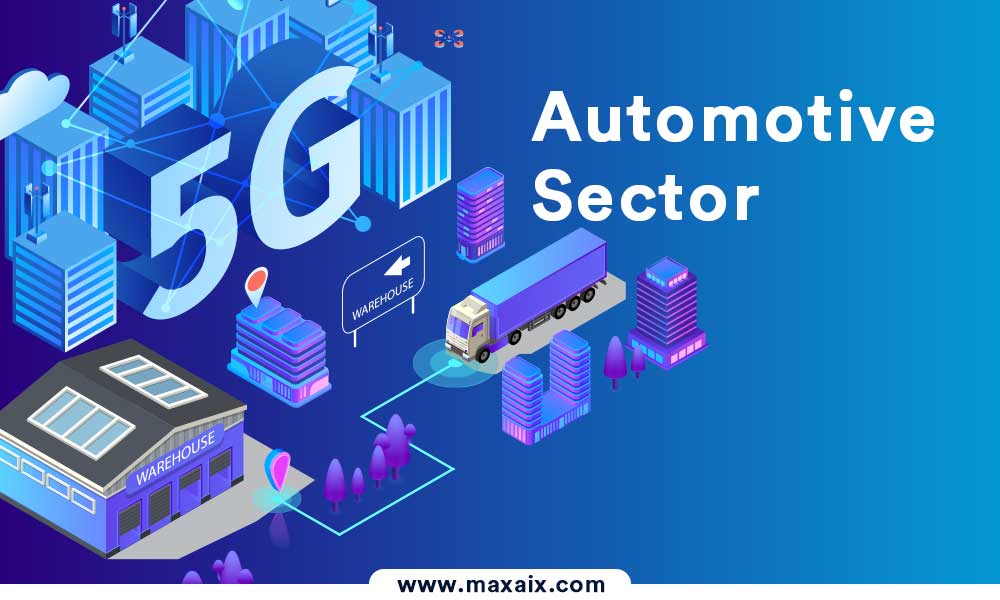How is 5G in the Automotive Industry More Efficient and Secure?

Introduction
5G technology is revolutionizing the automotive sector by significantly enhancing efficiency and security. The ultra-fast and low-latency capabilities of 5G networks enable real-time communication between vehicles, infrastructure, and other connected devices. This facilitates faster data exchange, allowing vehicles to make quicker and more informed decisions. Additionally, 5G supports advanced features like vehicle-to-everything (V2X) communication, enabling cars to communicate with each other, traffic signals, and even pedestrians. This seamless connectivity contributes to smoother traffic flow, reduced congestion, and improved overall efficiency. Moreover, 5G plays a crucial role in bolstering cybersecurity for connected vehicles. Its robust encryption and authentication mechanisms enhance the security of data transmission, protecting against potential cyber threats. As the automotive industry embraces 5G, we can anticipate a future with safer, more efficient, and interconnected transportation systems.
Advantages of 5G in the Transportation Industry
The advantages of 5G in the transportation industry extend beyond faster internet speeds. Some key benefits include:
- Low Latency: 5G’s low latency ensures real-time communication between vehicles, infrastructure, and systems.
- High Bandwidth: Increased bandwidth facilitates the seamless exchange of large amounts of data, essential for autonomous vehicles.
- Reliability: 5G networks are highly reliable, ensuring consistent connectivity crucial for safety-critical applications.
- Device Density: 5G supports a higher density of connected devices, allowing for better traffic management and communication between vehicles.
- Improved Safety: The low latency and reliability of 5G contribute to enhanced safety features in vehicles, reducing the risk of accidents.
- Efficient Traffic Management: 5G enables real-time traffic data exchange, leading to more efficient traffic management and reduced congestion.
- Autonomous Vehicle Support: 5G’s capabilities are integral to the functioning of autonomous vehicles, enabling quick decision-making and communication.
How is the growth of the 5G automotive industry changing the world of transportation?
The growth of the 5G automotive industry is reshaping transportation on a global scale:
- Connected Vehicles: 5G is driving the proliferation of connected vehicles, enabling seamless communication and data exchange.
- Autonomous Driving: The low latency of 5G is critical for the success of autonomous driving, providing the real-time connectivity needed for decision-making.
- Enhanced Efficiency: 5G contributes to more efficient traffic management, reducing congestion and improving overall transportation efficiency.
- Improved Safety: The reliability and low latency of 5G enhance the safety features in vehicles, preventing accidents and ensuring quicker emergency response.
- Innovative Services: The growth of 5G in the automotive sector is fostering the development of innovative services, such as in-car entertainment and personalized driving experiences.
Impact of 5G on the Automotive Industry: An Overview
The impact of 5G on the automotive industry is multi-faceted, influencing various aspects:
- Vehicle-to-Everything (V2X) Communication: 5G facilitates V2X communication, allowing vehicles to communicate with each other, infrastructure, pedestrians, and other connected devices.
- Autonomous Driving: 5G is a cornerstone for autonomous driving, providing the connectivity needed for real-time decision-making and coordination.
- Predictive Maintenance: The low latency of 5G enables vehicles to transmit data for predictive maintenance, reducing downtime and increasing overall reliability.
- In-Car Connectivity: 5G enhances in-car connectivity, offering passengers high-speed internet, entertainment options, and real-time information.
- Smart Traffic Management: 5G contributes to smart traffic management, optimizing traffic flow, reducing congestion, and improving overall transportation efficiency.
How Maxaix Accelerates Your 5G Automotive Ambitions
Maxaix accelerates 5G automotive ambitions with:
- Advanced Connectivity Solutions: Maxaix provides advanced connectivity solutions, ensuring seamless communication between vehicles and infrastructure.
- Edge Computing: Maxaix leverages edge computing to process data closer to the source, reducing latency and enhancing real-time decision-making.
- Security Measures: Maxaix integrates robust security measures to safeguard vehicle-to-everything communication, protecting against cyber threats.
- Scalability: Maxaix ensures scalability, allowing automotive applications to adapt to growing data and user demands.
- Customization: Maxaix allows for customization, and tailoring solutions to meet the specific needs of automotive clients.
10 Popular 5G Automotive Industry Use Cases in the United States, Canada, and the United Kingdom
a. Connected Traffic Lights: Improving Traffic Flow
Overview: 5G-enabled traffic lights communicate with vehicles, optimizing traffic flow.
Benefits:
Reduced congestion
Enhanced fuel efficiency
Quicker emergency vehicle response
Popularity: Adopted in urban areas of the US, Canada, and the UK to address traffic challenges.
b. Autonomous Delivery Vehicles: Transforming Last-Mile Logistics
Overview: 5G enables autonomous delivery vehicles for efficient last-mile logistics.
Benefits:
Faster and more reliable deliveries
Reduced delivery costs
Minimized traffic impact
Popularity: Gaining traction in urban centers for e-commerce and logistics services.
c. Intelligent Parking Systems: Streamlining Parking Processes
Overview: 5G supports intelligent parking systems, guiding drivers to available parking spaces.
Benefits:
Reduced search time for parking
Efficient use of parking spaces
Decreased traffic congestion
Popularity: Implemented in city centers to address parking challenges.
d. In-Car Entertainment and Connectivity: Elevating Passenger Experiences
Overview: 5G enhances in-car entertainment and connectivity for passengers.
Benefits:
High-speed internet for passengers
Seamless streaming and downloads
Real-time traffic and navigation updates
Popularity: Popular in luxury vehicles and ride-sharing services.
e. Fleet Management Systems: Optimizing Commercial Transportation
Overview: 5G supports fleet management systems for commercial transportation.
Benefits:
Real-time tracking of vehicles
Predictive maintenance for the fleet
Enhanced route optimization
Popularity: Widely adopted by logistics companies for efficiency gains.
f. Remote Vehicle Diagnostics: Enabling Predictive Maintenance
Overview: 5G facilitates remote vehicle diagnostics for predictive maintenance.
Benefits:
Reduced downtime for vehicles
Lower maintenance costs
Increased overall reliability
Popularity: Adopted by automotive manufacturers and service centers.
g. Cooperative Adaptive Cruise Control (CACC): Enhancing Traffic Flow
Overview: 5G supports CACC for cooperative and adaptive cruise control.
Benefits:
Smoother traffic flow
Reduced congestion
Improved fuel efficiency
Popularity: Being tested on smart highways across the US, Canada, and the UK.
Why is Each Case Popular in the United States, Canada, and the United Kingdom?
Connected Traffic Lights: Addresses urban traffic challenges prevalent in city centers.
- Autonomous Delivery Vehicles: Optimizes last-mile logistics in bustling urban areas.
- Intelligent Parking Systems: Tackles parking challenges in crowded city centers.
- Emergency Vehicle Communication: Ensures swift emergency responses in urban and suburban regions.
- In-Car Entertainment and Connectivity: Appeals to users in all regions, especially those in urban environments.
- Fleet Management Systems: Optimizes commercial transportation, crucial for logistics hubs.
- V2X Communication: Enhances road safety, which is important in densely populated areas.
- Remote Vehicle Diagnostics: Adopted by automotive service centers across regions.
- AR Navigation: Popular in high-end vehicles favored by consumers in affluent regions.
- CACC: Tested on smart highways to address traffic flow challenges in urban and suburban areas.
5 Reasons: Why Do People Like and Use This 5G Automotive?
- Enhanced Safety: 5G in automotive contributes to enhanced safety features, reducing the risk of accidents.
- Efficiency Gains: Users appreciate the efficiency gains in traffic management, parking, and delivery logistics.
- Innovative Experiences: In-car entertainment, AR navigation, and autonomous driving offer innovative and immersive experiences.
- Time Savings: Reduced search times for parking and quicker emergency response contribute to time savings.
- Environmental Impact: Efficiency gains contribute to reduced traffic congestion and fuel consumption, positively impacting the environment.
What Are the Challenges of Implementing 5G in the Automotive Industry?
The challenges of implementing 5G in the automotive industry include:
- Infrastructure Development: The need for widespread 5G infrastructure to support seamless connectivity
- Cost: The initial investment is required for 5G infrastructure and in-vehicle technology.
- Regulatory Hurdles: Addressing regulatory challenges and standards for 5G implementation
- Security Concerns: Ensuring robust cybersecurity measures to protect against potential threats
- Integration Complexity: Coordinating the integration of 5G technology with existing automotive systems
Frequently Asked Questions
Q1: How does 5G improve road safety in the automotive industry?
5G enhances road safety through features like collision avoidance, pedestrian safety, and real-time traffic information.
Q2: Can 5G be implemented in all types of vehicles?
Yes, 5G can be implemented in various vehicles, from consumer cars to commercial fleets.
Q3: What role does 5G play in autonomous driving?
5G is crucial for autonomous driving, providing the low latency and high-speed connectivity needed for real-time decision-making.
Q4: How does 5G benefit commercial transportation and logistics?
5G optimizes commercial transportation by supporting fleet management systems, real-time tracking, and predictive maintenance.
Q5: Are there privacy concerns with the implementation of 5G in vehicles?
Privacy concerns exist, but measures such as encryption and secure authentication are in place to address them.
Q6: Can 5G improve the efficiency of emergency response in vehicles?
Yes, 5G facilitates communication between emergency vehicles and traffic systems, ensuring quicker response times.
Q7: What are the potential entertainment features of 5G in-car connectivity?
In-car connectivity powered by 5G can offer features like high-speed internet, streaming, real-time navigation updates, and interactive content.
Q8: How can 5G help reduce traffic congestion?
5G contributes to reducing traffic congestion through features like connected traffic lights, intelligent parking systems, and cooperative adaptive cruise control.
Q9: Is 5G technology compatible with existing automotive systems?
Yes, efforts are made to ensure compatibility, but some integration challenges may arise, necessitating updates to existing systems.


